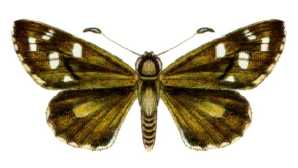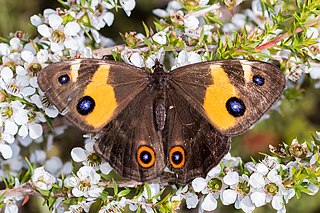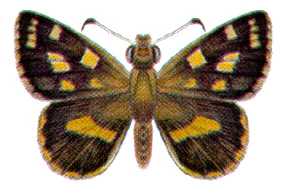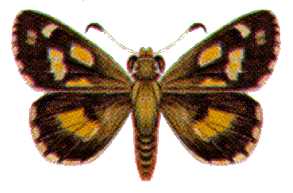The 2007–08 Pura Cup was the 106th season of official first-class domestic cricket in Australia. Six teams representing six states in Australia participated in the competition. The 2007 competition began on 12 October, when the previous season's champions, Tasmania took on Queensland at the Gabba. New South Wales were crowned champions for the 45th time in their history as they beat Victoria by 258 runs in the Pura Cup final.

Gahnia is a genus of sedges native to China, Southeast Asia, New Guinea, Australia, New Zealand and a number of Pacific Islands. The common name is due to the toothed margins. It often forms tussocks.

Gahnia filum, the chaffy saw-sedge, is a tussock-forming perennial in the family Cyperaceae, endemic to Australia. It grows to between 60 and 110 cm in height.

Gahnia trifida, the coastal saw-sedge, is a tussock-forming perennial in the family Cyperaceae, endemic to southern Australia.

Antipodia atralba, the black and white skipper, is a species of butterfly of the family Hesperiidae. It is found in Australia along the coast of Victoria and South Australia.
Antipodia dactyliota is a species of butterfly of the family Hesperiidae. It is found in Western Australia.

Tisiphone abeona, the swordgrass brown, is a nymphalid butterfly. It is endemic to Australia.

Hesperilla chrysotricha, also known as the chrysotricha skipper or goldenhaired sedge-skipper, is a species of butterfly in the family Hesperiidae. It is found in the Australian states of Victoria, Tasmania, South Australia and Western Australia.

Hesperilla crypsargyra, also known as the silvered skipper or silver hedge-skipper, is a species of butterfly in the family Hesperiidae. It is found in the Australian states of New South Wales, Queensland and Victoria.

Hesperilla donnysa, also known as the donnysa skipper or varied sedge skipper, is a species of butterfly in the family Hesperiidae. It is found in the Australian Capital Territory, New South Wales, Queensland, South Australia, Tasmania, Victoria and Western Australia.

Hesperilla idothea, commonly known as the flame sedge-skipper, is a species of butterfly in the family Hesperiidae. It is found in the Australian states of New South Wales, Queensland, South Australia and Victoria.

Hesperilla ornata, also known as the spotted skipper or spotted sedge-skipper, is a species of butterfly in the family Hesperiidae. It is found along the non-tropical eastern seaboard of mainland Australia and in the adjacent mountain ranges.

Hesperilla perornata, the montane sedge-skipper or mountain spotted skipper, is a butterfly of the family Hesperiidae. It is found in the mountains of the Australian states of New South Wales and Victoria.

Timoconia peron, the large dingy skipper or dingy grass-skipper, is a butterfly of the family Hesperiidae. It is found in the Australian Capital Territory, New South Wales, Queensland and Victoria.

Gahnia grandis is a tussock-forming perennial plant found in southeastern mainland Australia and Tasmania.

Gahnia sieberiana, commonly known as the red-fruit saw-sedge, is a tussock-forming perennial plant in the family Cyperaceae, endemic to Australia. It is a widespread plant that favours damp sunny sites. Many insect larvae have been recorded feeding on the red-fruit saw-sedge. It may grow over 2 metres tall.
The Peter Murrell Conservation Area is located in Huntingfield, Tasmania, approximately 15 km (9.3 mi) south of the state's capital city, Hobart. The conservation area has an area of 135 ha and is one of three reserves within the Peter Murrell Reserves. Also within these reserves are the Peter Murrell State Reserve and a Public Reserve. These reserves and the Conservation Area lie at the base of the Tinderbox Peninsula, between the suburbs of Kingston, Howden and Blackman's Bay. The Peter Murrell Conservation Area surrounds the northern, western and southern sides of the Peter Murrell State Reserve.
Gahnia lanigera, also known as the black grass saw-sedge, desert saw-sedge or little saw-sedge, is a species of flowering plant in the sedge family that is found in southern Australia. The specific epithet lanigera means 'woolly'.

Gahnia microstachya is a tussock-forming perennial in the family Cyperaceae, that is native to south eastern parts of Australia from New South Wales to Tasmania.















